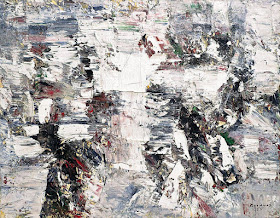Paul-Émile Borduas (November 1, 1905 – February 22, 1960) was a Québec painter known for his abstract paintings. He was the leader of the avant-garde Automatiste movement and the chief author of the Refus Global manifesto of 1948. Borduas had a profound impact on the development of the arts and of thought, both in the province of Quebec and in Canada.Borduas was born on November the first, 1905, in Saint-Hilaire, Quebec (a small village 50 kilometers from Montréal). He was the fourth child of Magloire Borduas and Éva Perrault. As a child he engaged in bricolage - his first known artistic activity. He received five years of formal elementary school education, (which ended at the age of twelve) and some private lessons from a village resident. Fortuitously, Borduas met Ozias Leduc in the winter of 1921-1922, and Leduc agreed to take the young artist under his wing. At the age of sixteen he became an apprentice to Ozias Leduc, who was a church painter and decorator. Leduc provided Borduas with a basic artistic training, teaching him how to restore and decorate churches. Leduc arranged for Borduas' instruction at the École Technique, in 1919, in Sherbrooke, Québec. In 1923, assisted by a scholarship Leduc had secured for him, he enrolled in the École des Beaux-Arts de Montréal, continuing to work for Leduc at the same time. He received prizes for his paintings at both of these institutions. Despite discord between Borduas and the school administration, he continued his studies at Leduc's urgings
Borduas wrote Refus Global (or "Total Refusal", anglicized) in late 1947- early 1948. It was disseminated in a folder that contained other Automatists' writings. This piece was originally intended to accompany an Automatist showing, however it was actually distributed alone. "Global Refusal" served as an important manifesto that advocated the separation of church and state in Quebec, especially for the arts. In it Borduas "denounces the forces of oppression that had made of Quebec a suffocating environment. hostile to both individual and collective creativity".
We foresee a future in which man is freed from useless chains, to realize a plenitude of individual gifts, in necessary unpredictability, spontaneity and resplendent anarchy. Until then, without surrender or rest, in community of feeling with those who thirst for better life, without fear of set-backs, in encouragement or persecution, we shall pursue in joy our overwhelming need for liberation.
Four hundred copies of the manifesto went on sale August 9, 1948. Borduas was dismissed from l'École du Meuble on September 2 as a direct result of his involvement in this social critique. Even those who had tired of the repressive Duplessis régime, and advocated great social changes in Québec, were reluctant to back Borduas' thorough condemnation of the Catholic Church—such a central influ nce on the French Canadian populace.
We foresee a future in which man is freed from useless chains, to realize a plenitude of individual gifts, in necessary unpredictability, spontaneity and resplendent anarchy. Until then, without surrender or rest, in community of feeling with those who thirst for better life, without fear of set-backs, in encouragement or persecution, we shall pursue in joy our overwhelming need for liberation.
Four hundred copies of the manifesto went on sale August 9, 1948. Borduas was dismissed from l'École du Meuble on September 2 as a direct result of his involvement in this social critique. Even those who had tired of the repressive Duplessis régime, and advocated great social changes in Québec, were reluctant to back Borduas' thorough condemnation of the Catholic Church—such a central influ nce on the French Canadian populace.
Borduas was ostracized, he was unable to attain employment and this was necessarily problematic as he was a father. He decided to take matters into his own hands. Borduas produced another piece in his defence, «Projections Libérantes» («Liberating Projections»), which he completed in February 1949.[7] Unfortunately, this more moderate composition, which clearly communicated Borduas' intentions in releasing «Refus Global», was not enthusiastically received by the public or the presses. However, despite early denouncements, the manifesto marked the beginning of profound social change in Quebec and signaled the dawn of the Quiet Revolution.In 1953 Borduas moved to New York, where he saw the works of Jackson Pollock, Franz Kline and Mark Rothko and began to use the palette knife to apply his paint. In 1955 he moved back to Paris where he died of a heart attack in 1960.
In 1954, works by Borduas, along with those of B. C. Binning and Jean-Paul Riopelle represented Canada at the Venice Biennale. In 1955 he represented Canada at the 3rd Bienal de São Paulo. In 1960 the Stedelijk Museum in Amsterdam gave him the posthumous exhibition, «Borduas 1905–1960» . In 1988 the Montreal Museum of Fine Arts gave him an enormous retrospective exhibition curated by François-Marc Gagnon.In May 2012 his painting Froissement Multicolore sold for $663,750 at auction, surpassing the artist's previous auction price record by $150,000.Wikipedia
In 1954, works by Borduas, along with those of B. C. Binning and Jean-Paul Riopelle represented Canada at the Venice Biennale. In 1955 he represented Canada at the 3rd Bienal de São Paulo. In 1960 the Stedelijk Museum in Amsterdam gave him the posthumous exhibition, «Borduas 1905–1960» . In 1988 the Montreal Museum of Fine Arts gave him an enormous retrospective exhibition curated by François-Marc Gagnon.In May 2012 his painting Froissement Multicolore sold for $663,750 at auction, surpassing the artist's previous auction price record by $150,000.Wikipedia


























































